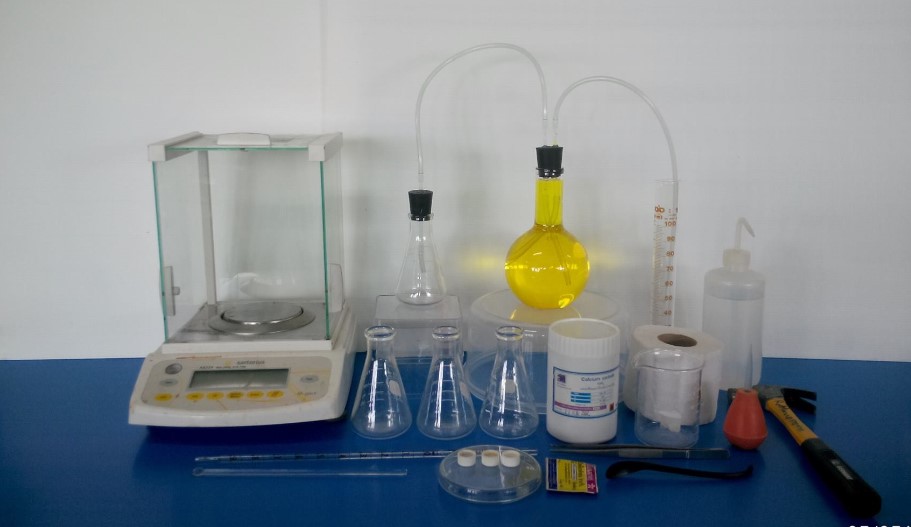การสาธิตทดลอง เรื่อง สารกำหนดปริมาณ โดยใช้ปฏิกิริยาระหว่างแคลเซียมคาร์ไบด์กับน้ำ
Main Article Content
Abstract
Juthamas Malila, Suparb Tamuang, Maliwan Amatatongchai, Purim Jarujamrus and Sanoe Chairam
รับบทความ: 2 กันยายน 2558; ยอมรับตีพิมพ์: 12 พฤศจิกายน 2558
บทคัดย่อ
บทความวิจัยการทดลองในชั้นเรียนนี้มีวัตถุประสงค์เพื่อต้องการนำเสนอครูผู้สอนเคมีด้วยการสาธิตทดลองอย่างง่าย เรื่อง สารกำหนดปริมาณ โดยใช้ปฏิกิริยาระหว่างแคลเซียมคาร์ไบด์กับน้ำ ในการศึกษาในครั้งนี้ กำหนดให้น้ำหนักของแคลเซียมคาร์ไบด์คงที่ จากนั้นเพิ่มปริมาตรน้ำปริมาณมากขึ้นเรื่อย ๆ และวัดปริมาตรของแก๊สอะเซทิลีนที่เกิดขึ้นโดยอาศัยการแทนที่น้ำ การสาธิตทดลองนี้สามารถนำไปสาธิตนักเรียนในหัวข้อสารกำหนดปริมาณในห้องปฏิบัติการเคมีได้เป็นอย่างดี
คำสำคัญ: การสาธิตทดลอง สารกำหนดปริมาณ แคลเซียมคาร์ไบด์ น้ำ ระดับมัธยมศึกษา
Abstract
This laboratory classroom research aimed to provide chemistry teachers with a simple experimental demonstration of limiting reagent using the reaction between calcium carbide and water. In this study, the amount of calcium carbide was fixed, while the volume of water was gradually increased. Then, the volume of acetylene gas generated from the reaction was measured by the displacement of water. This experimental demonstration can be used to demonstrate students the concept of limiting reagent in chemistry laboratory.
Keywords: Experimental demonstration, Limiting reagent, Calcium carbide, Water, Secondary level
Downloads
Article Details

This work is licensed under a Creative Commons Attribution-NonCommercial 4.0 International License.
References
Artdej, R., and Thongpanchang, T. (2008). A Dramatic classroom demonstration of limiting reagent using the vinegar and sodium hydrogen carbonate reaction. Journal of Chemical Education 85(6): 1382–1384.
Chen, M-Y., Wang, J-X., Chen, K.-T., Wen, B-Z, Lin, W.-C., and Chen, C-C. (2012). Transesterification of soybean oil catalyzed by calcium hydroxide which obtained from hydrolysis reaction of calcium carbide. Journal of the Chinese Chemical Society 59(2): 170–175.
Chuentragool, P., Vongnam, K., Rashatasakhon, P., Sukwattanasinitt, M. (2011). Calcium carbide as a cost-effective starting material for symmetrical diarylethynes via Pd-catalyzed coupling reaction. Tetrahedron 67: 8177-8182.
Ministry of Education (MOE). (2011). The Curriculum 2008. Bangkok: Ministry of Education (in Thai).
Moo, J. G. S., Wang, H., and Pumera, M. (2014). Acetylene bubble-powered autonomous capsules: towards in situ fuel. Chemical Communications 50: 15849–15851.
Nattapong Makaratat. (2014). Use of calcium carbide residue-fly ash as binder to produce high workability concrete. Journal of Industrial Technology 10(3): 106–120. (in Thai).
Nyasulu, F., Paris, S., and Barlag, R. (2009). Wash bottle laboratory exercises: mass of NaHCO3 in an alka-Seltzer tablet, molar mass of CO2, and the ideal gas law constant. Journal of Chemical Education 86(7): 842–844.
Proksa, M., and Tóthová, A. (2006). Using balloons for a dramatic presentation of the acid–bicarbonate reaction. Journal of Chemical Education 83(10): 1471–1472.
Yu, A. (2010). Exploring the Ideal Gas Law through a Quantitative gasometric analysis of nitrogen produced by the reaction of sodium nitrite with sulfamic acid. Journal of Chemical Education 87(12): 1369–1371.
